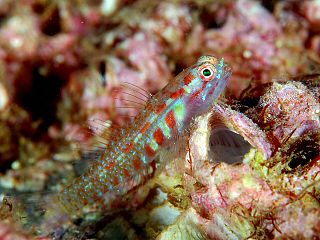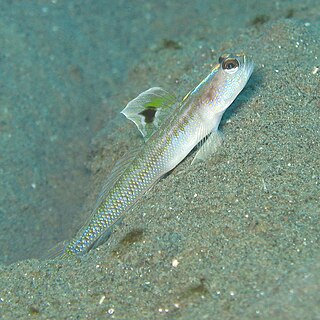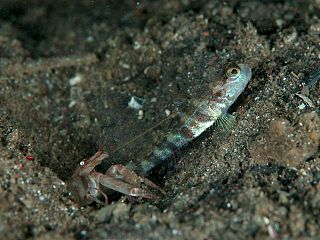
Eleotridae is a family of fish commonly known as sleeper gobies, with about 34 genera and 180 species. Most species are found in the tropical Indo-Pacific region, but there are also species in subtropical and temperate regions, warmer parts of the Americas and near the Atlantic coast in Africa. While many eleotrids pass through a planktonic stage in the sea and some spend their entire lives in the sea; as adults, the majority live in freshwater streams and brackish water. One of its genera, Caecieleotris, is troglobitic. They are especially important as predators in the freshwater stream ecosystems on oceanic islands such as New Zealand and Hawaii that otherwise lack the predatory fish families typical of nearby continents, such as catfish. Anatomically, they are similar to the gobies (Gobiidae), though unlike the majority of gobies, they do not have a pelvic sucker.

Gobiodon is a genus of gobies also known as coral gobies or "clown gobies". Generally, coral gobies, unlike the rest of the family Gobiidae, are not burrowers, but instead prefer to inhabit the branches of certain Acropora or similar hard corals.

Eviota is a genus of fish in the family Gobiidae, commonly as dwarfgobies found in the Indo-Pacific region, where it is distributed from Japan to Australia and from Africa to Pitcairn Island. Species are mainly associated with coral reefs. Many of these fish are short-lived, with life cycles as brief as 3.5 weeks in the tropics. Some species are hermaphrodites and some representatives live symbiotically among the tentacles of the mushroom coral.

Rhinogobius is a genus of primarily freshwater gobies native to tropical and temperate parts of eastern Asia. Most are small, streamlined in shape, and often sexually dimorphic. Few are of commercial importance, but R. duospilus is fairly widely traded as an aquarium fish.

Gobius is a genus of fish in the family Gobiidae native to fresh, brackish and marine waters of and around Europe, Africa and Asia. It contains the typical gobies, being the type genus of the formerly recognised subfamily Gobiinae and family and the namesake genus of its order Gobiiformes.

The Gobiiformes are an order of fish that includes the gobies and their relatives. The order, which was previously considered a suborder of Perciformes, is made up of about 2,211 species that are divided between seven families. Phylogenetic relationships of the Gobiiformes have been elucidated using molecular data. Gobiiforms are primarily small species that live in marine water, but roughly 10% of these species inhabit fresh water. This order is composed chiefly of benthic or burrowing species; like many other benthic fishes, most gobiiforms do not have a gas bladder or any other means of controlling their buoyancy in water, so they must spend most of their time on or near the bottom. Gobiiformes means "Goby-like".

Vanderhorstia is a genus of gobies native to the Indian and Pacific oceans. The name of this genus honours the Dutch biologist Cornelius van der Horst (1889-1951) of the University of The Witwatersrand, Johannesburg, who was well known for his interest in marine biology.

Tomiyamichthys is a genus of gobies found from the Red Sea through the Indian Ocean to the western Pacific Ocean. The name of this genus honours the Japanese ichthyologist Itiro Tomiyama of the Tokyo Imperial University, who described the type species, Tomiyamichthys oni, in 1936.

Gobiodon histrio, the Broad-barred goby, is a species of goby native to the Indian Ocean from the Red Sea to the western Pacific Ocean to southern Japan, Samoa and the Great Barrier Reef. This species is a reef dweller, being found at depths of from 2 to 15 metres. It can reach a length of 3.5 centimetres (1.4 in) TL. This species can also be found in the aquarium trade.

Didogobius is a genus of small marine fish in the family Gobiidae, the true gobies. They are native to the eastern Atlantic Ocean and the Mediterranean Sea. The name of the genus is a compound noun made up of Dido, the mythical founder and first queen of Carthage, and the Latin gobius meaning "goby".

Asterropteryx is a genus of fish in the family Gobiidae found in the Indian and Pacific Ocean.

Callogobius is a genus of fish in the family Gobiidae found in brackish and marine waters of the Indian and Pacific Ocean.
Coryogalops is a genus of gobies native to the southeastern Atlantic Ocean and the western Indian Ocean along the coasts of Africa and Asia from South Africa to Pakistan.

Grallenia is a genus of fish in the family Gobiidae native to the western Pacific Ocean.
Hetereleotris is a genus of gobies native to the western Indian Ocean and the western Pacific Ocean.

The largetooth goby, also known as Wilbur's goby, is a species of ray-finned fish from the family Gobiidae which is native to the Indo-Pacific from the Seychelles to Micronesia. Its known range has been extended to the Red Sea as specimens were photographed at one site and collected at another site off Egypt. This species lives in sheltered marine waters at depths of from 0 to 20 metres preferring areas with sandy substrates. This species grows to a length of 6.5 centimetres (2.6 in) SL. This species is the only known member of its genus. This species is not obviously sexually dimorphic and it has a background colour of pale brown to greenish-brown and a pale ventral side. The body is marked with brown and white spots, pairs of larger brown spots create a mid-lateral row along its flanks and there is a dark spot on the caudal fin peduncle. It has a brown blotch on the cheek and a series of short brown bars along its back. The largetooth goby is a solitary fish which is found in coastal bays, lagoons and estuaries over fine sandy substrates close to the margins of reefs or silt beds in the vicinity of sheltered and often turbid coastal reefs. It is most frequently collected from shallow waters to 7 metres (23 ft), around coral reefs but off southern Japan, the largetooth goby occurs at the bottom of sandy bays. The specific name honours the American physician, Ray Lyman Wilbur (1875–1949) who was president of Stanford University from 1916–1943, as well as being the United States Secretary of the Interior from 1929–1933. Wilbur helped the author, Herre, get to Palau, the type locality of this species.

Myersina is a genus of ray-finned fish from the family Gobiidae, the true gobies which are found from the Atlantic coast of South Africa through the Indian Ocean to the western Pacific Ocean. The generic name honours the American ichthyologist George S. Myers (1905-1985) who was a younger colleague of Herre's at the time at which he described the genus and who went on to be president of the American Society of Ichthyologists and Herpetologists, the head of the Division of Fishes at the United States National Museum and an ichthyologist for the United States Fish and Wildlife Service.

Obliquogobius is a genus of gobies native to the Indian Ocean and the northwestern Pacific Ocean.

Pleurosicya is a genus of gobies native to reef environments of the Indian Ocean and the western Pacific Ocean.
Sueviota is a genus of fish in the family Gobiidae native to the Indian and Pacific Ocean.

















